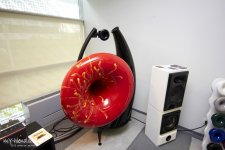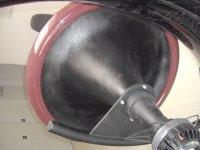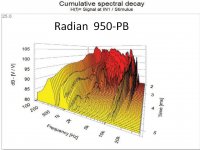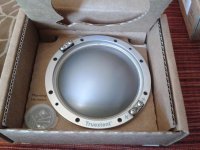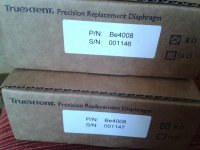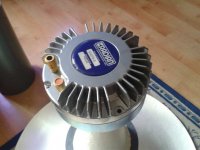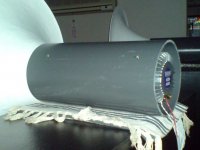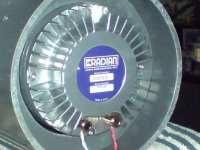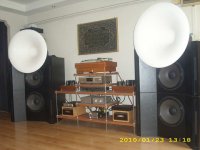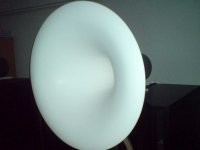Well the size/freq speaks more to a 1.4" driver than a 2" driver. I would think 2 to 1.4" adapters would exacerbate the type of horn exit problems Identified by Geddes for example.
Very true - as pos mentioned the exit diameter is going to cause the dispersion pattern to drop off (at the top octave) for almost any design that doesn't utilize diffraction.
Real 2" exit horns that are designed for operation from around 900 Hz to 20 kHz (and "small") are pretty much non-existent - especially if you want a wider high freq. dispersion pattern.
That's why I think it will need to be a custom design, and the e-oswg-15 seems to come closest to the overall desired parameters but lacks that 2" exit (..that is *without* a diffraction device).
Actually I listen to the 950pb without any horn at the moment as the tractrix drives me nuts.Jeppe
For the 2" exit diameter Radian 950-PB compression driver:
If you run a s-l-o-w sweep of sine waves from 5KHz to 20Khz you should be able to hear: attenuation; diaphragm break-up modes; beaming from the large diameter diaphragm; and phase plug limitations. A crossover cannot remove the break-up mode distortion or the high frequency beaming common from a 4" diameter diaphragm.
The main reason a low-height horn/waveguide like the SEOS is recommended with a large diameter midbass like your TAD TM-1201H is to minimize the center-to-center spacing in an effort to limit lobing(comb filtering). If you run a sinewave on a multi-horn around the Xover frequency and walk around your room comb filtering will generate SPL peaks and valleys.
Dr. Geddes has performed extensive measurements on controlled directivity and polar response to educate why his Summa OS-waveguide speakers use just a 1" diameter compression driver. It is necessary(but not sufficient) for a speaker to measure good to sound good.
Many multi-horn speaker designs seem willing to accept a known "crazy tweeter placement" in favor of 2" compression driver dynamics on a large horn. The stereo illusion is just a Jedi mind trick anyway ... "That is not the horn you are looking for", said Obi-Wan.
Attachments
Is there any driver equipped with 3" or 4" diaphragm and 1" exit?
Denovo BA-750 Compression Driver - Tweeters - Drivers DIY Sound Group
For the 2" exit diameter Radian 950-PB compression driver:
If you run a s-l-o-w sweep of sine waves from 5KHz to 20Khz you should be able to hear: attenuation; diaphragm break-up modes; beaming from the large diameter diaphragm; and phase plug limitations. A crossover cannot remove the break-up mode distortion or the high frequency beaming common from a 4" diameter diaphragm.
Just FYI, the Radian 951 is basically the 950 with a Be Diaphragm and a 1.4" exit / different phase plug. I think the 950 can be sent in/ modded into that and certainly measures nicely:
http://www.behringer-electric.de/im...nt/Vergleichstest 951PbTrExt4016 vs 476Be.pdf
But the problem is still that you need a good horn with a matching throat angle. If for example the SEOS-15 is our horn of choice, that's a 1" entrance and won't work smoothly with a 1.4" exit CD
Perhaps the Auto-tech guys want to make a SEOS-24 specifically for the Radian 951 - it would be glorious But that brings us right back to the issue of only wanting a 16" wide horn.
No picture, my system is ugly
As for another horn suggestion, if you are going to use a tweeter and keep the Radian in its 2" state you can try the "new" square tractrix horns from stereo lab:
Tractrix Horns Vintage Series - STEREO LAB
Given the dimensions it might be less beamy than their round offering...
If you can convert your Radian into a 1.5" driver (I think everything is possible: 2"/1.5"/1.4") with the proper bolt pattern, then you can also try the JBL PT waveguides, which come in different dimensions (square or rectangulat, 12" large) and directivities (60*40, 90*50, 100*100) and are usable down to ~1200Hz.
Hi Pos
I'll try contacting them - perhaps they know a thing or two about the dispersion.
Unfortunately I've never seen a DIY TAD based system that look great, so perhaps that is just how things are.

/Jeppe
Go for the JMLC-400, the absolute best match for the TM-1201. Been there, done that.
Isn't the JMLCs quite beamy? Also pretty difficult to minimize C-C-spacing with these horns.
For the 2" exit diameter Radian 950-PB compression driver:
If you run a s-l-o-w sweep of sine waves from 5KHz to 20Khz you should be able to hear: attenuation; diaphragm break-up modes; beaming from the large diameter diaphragm; and phase plug limitations. A crossover cannot remove the break-up mode distortion or the high frequency beaming common from a 4" diameter diaphragm.
The main reason a low-height horn/waveguide like the SEOS is recommended with a large diameter midbass like your TAD TM-1201H is to minimize the center-to-center spacing in an effort to limit lobing(comb filtering). If you run a sinewave on a multi-horn around the Xover frequency and walk around your room comb filtering will generate SPL peaks and valleys.
Dr. Geddes has performed extensive measurements on controlled directivity and polar response to educate why his Summa OS-waveguide speakers use just a 1" diameter compression driver. It is necessary(but not sufficient) for a speaker to measure good to sound good.
Many multi-horn speaker designs seem willing to accept a known "crazy tweeter placement" in favor of 2" compression driver dynamics on a large horn. The stereo illusion is just a Jedi mind trick anyway ... "That is not the horn you are looking for", said Obi-Wan.
I will try sweeping them at some time. So you suggest to get rid of the 950s and buying SEOS 1" horns and a driver like the TAD TD-2001? Or?
Thanks,
Jeppe
Isn't the JMLCs quite beamy? Also pretty difficult to minimize C-C-spacing with these horns.
Definitely not the size in question here.
I will try sweeping them at some time. So you suggest to get rid of the 950s and buying SEOS 1" horns and a driver like the TAD TD-2001? Or?
Thanks,
Jeppe
Ditch a driver you really like for the horn you *think* you want..
-sounds like "putting the cart before the horse" to me.
So you suggest to get rid of the 950s and buying SEOS 1" horns and a driver like the TAD TD-2001? Or?Jeppe
A Man of Character marries one woman for life, but fools around with several different speakers
Your current speakers with the TAD TM-1201H midbass push enough energy into the room to give the illusion that a 200lb physical body is singing in the room. A 2000lb physical piano is playing. A SEOS_15 and medium cost 1" compression driver like the Radian 475PB would be a good option to complete your speaker.
A 2" compression driver midrange horn has a different pressure function than a TAD TM-1201H.
You could keep the Radian 950-PB mistress for a future big JMLC midrange horn speaker that has electrostatic midrange details with confused tweeter upper harmonics. (read Lynn Olson's thread "I do not give great weight to directivity control. I know that Dr. Floyd Toole and Dr. Geddes place directivity control high on their list of priorities, but I must respectfully disagree with them, while agreeing on many other points. I very strongly agree about the importance of uniform and flat response at the listening position...")
What do you mean?A 2" compression driver midrange horn has a different pressure function than a TAD TM-1201H.
In my tests I found 4" drivers better than 1.75" drivers in almost any respect, even when used only above 1khz.
In my tests I found 4" drivers better than 1.75" drivers in almost any respect, even when used only above 1khz.
I think it is typical to cross the Radian 950PB 4" diaphragm compression driver around 7Khz to a super-tweeter in order to avoid the breakup ~10Khz, and beaming if the higher frequency is boosted.
Radian 950PB Spectral Decay Plot attached. Long decay ~10Khz indicates breakup energy
Attachments
...i have been listening to the 950pb with the AH204 azurahorns for more than 2 years now. partnering them, are 4 onken style cabs with usher 15" 15HM drivers crossed at 400hz. liked the sound so far with no apparent beaming as compared to my previous lowther pm4 in a similar setup.
Attachments
Last edited by a moderator:
I think it is typical to cross the Radian 950PB 4" diaphragm compression driver around 7Khz to a super-tweeter in order to avoid the breakup ~10Khz, and beaming if the higher frequency is boosted.
Radian 950PB Spectral Decay Plot attached. Long decay ~10Khz indicates breakup energy
If you turn them into 1.4" drivers (throat less) and install truextent diaphragms both of these drawbacks disappear
Those truextent diaphragms still require EQ in the top end (at least to counter the rise in impedance of the motor, but also because the massbreak point is still in the middle of the band), but they take it without problem, and without much breakup until at least 16khz.
I am using JBL 2450SL (1.5") and truxtent diaphragms now, and nothing I have heard come close (even the JBL 2435H is really far from that).
The Radian motor is supposed to be even better with its 5-slit phasing plug (better directivity control in the UHF).
1" compression driver sound thin in comparison, even when used only above 1khz.
Last edited:
If you turn them into 1.4" drivers (throat less) and install truextent diaphragms both of these drawbacks disappear
Those truextent diaphragms still require EQ in the top end (at least to counter the rise in impedance of the motor, but also because the massbreak point is still in the middle of the band), but they take it without problem, and without much breakup until at least 16khz.
I am using JBL 2450SL (1.5") and truxtent diaphragms now, and nothing I have heard come close (even the JBL 2435H is really far from that).
The Radian motor is supposed to be even better with its 5-slit phasing plug (better directivity control in the UHF).
1" compression driver sound thin in comparison, even when used only above 1khz.
Note: Most of the poor linear decay at the top of the Radian's pass-band is likely a product of its linear behavior (or lack thereof). EQ it and most of that "hash" should disappear provided there is a smooth transition from driver exit to "horn entrance". (..of course the equalization would be complex - requiring digital filtering.)
A 1.4" exit adapter will almost certainly compromise the phase path of compression driver. It also alters the compression ratio (..and in a negative manner).
The 950PB should be good enough for most people, with only the top octave not fully developed. Perceptually this can be compensated for with a rear radiating super tweeter.
 j45yip, I've fixed your photos (90% reduction in file size)
j45yip, I've fixed your photos (90% reduction in file size)Please read this thread:
http://www.diyaudio.com/forums/everything-else/183084-pictures-why-not-attach-them.html
Thanks!
...hi pano, noted. sorry and thanks for the follow up action.
j45yip, I've fixed your photos (90% reduction in file size)
Please read this thread:
http://www.diyaudio.com/forums/everything-else/183084-pictures-why-not-attach-them.html
Thanks!
Thanks for sharing. That's a monster.
But it seems no one has used or shared the results yet. I'm wondering how the big titanium dome would work in the top range.
- Status
- This old topic is closed. If you want to reopen this topic, contact a moderator using the "Report Post" button.
- Home
- Loudspeakers
- Multi-Way
- Horn for Radian 950pb
